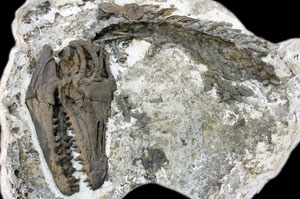
A crew from the Royal Tyrrell Museum is braving the frosty winter air to recover the remains of a mosasaur (MO-sa-sore), a marine reptile that lived alongside the dinosaurs.
The fossil was discovered on February 16 at the Korite Mine near Lethbridge. Staff were mining for ammolite, an opal-like gemstone popular in jewellery, when they exposed the tail of a mosasaur.
A Tyrrell crew rushed to the site. Originally, it was thought that only the tail was present, but as crews carefully dug around the beast more and more of the skeleton was exposed.
In the end, a full specimen, six to seven metres long with a skull 60 to 70 centimetres long, was exposed. The find ranks as one of the most completely preserved mosasaur fossil discovered in Alberta.
It is estimated the fossil is between 70 to 75 million years old.
The new discovery differs from another mosasaur, Prognathodon, which was found at the mine. It has a shorter snout, relative to the length of the body, slender, sharp teeth, and large eye sockets.
“The skull is dispproportionaltely small compared to the total length of the animal,” said Takuya Konishi, postdoctoral fellow and researcher at the Tyrrell Museum. “That could mean many things. I’m excited to explore what it could be.”
Konishi has spent his graduate career researching the extinct marine reptiles and has some ideas that could explain the differences.
“My suspicion is that it’s a sub-adult individual. If that’s the case it tells an interesting and unknown story of how mosasaurs grew,” said Konishi. Large eye sockets are typically a juvenile feature and the animal may not have been an adult when it died.
Another possibility is that the new find is an entirely new species of mosasaur.
“It’s been almost five years since we’ve found a marine reptile at the Korite Mine,” said Andrew Neuman, Executive Director of the Royal Tyrrell Museum. “The Korite Mine and Museum maintain a positive relationship, which has led to the recovery of a number of significant fossils.”
One of those significant fossils is the focus of the Tyrrell Museum’s “Alberta’s Last Sea Dragon – Solving an Ancient Puzzle”, the newest exhibit in the works for the galleries.
In 2007, the remains of an elasmosaur (ell-AZ-mo-sore), a long-necked marine reptile, were unearthed at the same mine and will be the focus of the new exhibit.
Mosasaurs lived in the Cretaceous seas (145 to 65 million years ago) and were fully adapted for an aquatic lifestyle. Rather than arms and legs, the animals had a set of four flippers that, together with a long tail, were used to propel them through the water.
A popular misconception is that mosasaurs were dinosaurs. However, research suggests that mosasaurs evolved from monitor lizards, a living example of which is the komodo dragon.
It is expected the new fossil will arrive at the museum this week. From there, the long process of preparation will commence and the remains will be studied by the experts at the Tyrrell Museum.